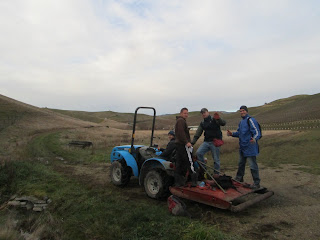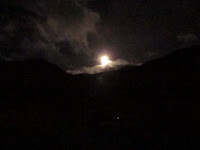Since late March our home base has been in the Marlborough Region of the South Island where vineyards cover the landscape. After bottling some wine at a fancy winery we spent a couple weeks sporadically picking grapes during the harvest. We had heard that a few weeks after the last grapes were picked the winter pruning season would begin and this was a good time to save up some traveling cash. Upon returning from our South Island road trip, our bank accounts were in need of some serious fattening so we settled in and waited for the pruning to begin. When the first few jobs trickled in we spent some very frustrating days struggling to earn about $60-70 dollars a day. But as we gained experience and bounced from one contractor to the next we eventually began earning more substantial paychecks. For the past month we had the good fortune of working for one of the higher paying contractors of the region. Theresa has proved to be a speedy vine trimmer and wrapper and I have held my own as a vine pruner and stripper. The main focus for the past two months has been work- though we have had some fun weekends with friends down the road staying at the hostel/historic tavern. Our only road-trip since the South Island tour has been an overnight jaunt to the golden beaches and clear blue water of Abel Tasman National Park (a trip that convinced us that we must someday return to NZ to further explore this coastal paradise). We've been sharing a house with a few other couples so we've enjoyed a little more comfort and space than we experienced living amongst backpackers in the hostels. Today was our last day of work in the vineyards before we pack up and drive to Auckland in order to catch our flight to Australia. It felt like the first day of summer (though we are in the middle of NZ winter) as we left the vineyard.
Here is a little piece I wrote towards the beginning of our vineyard pruning experience:
 |
| Vineyard sunrise |
A day in the vineyard-
I often wake before the alarm, anticipating the dreadful beeping. Sometimes the aching in my arms and hands has had me up for hours anyway. I put on smelly clothes which are sometimes still damp from the previous days sweat. It’s too cold in this room for even a little perspiration to dry off- kiwi’s apparently don’t believe in insulation or central heating. After a quick breakfast I step outside into the darkness of predawn Marlborough- wine country New Zealand.
The whole crew of backpackers- German, French, Japanese, etc.- as well as a handful of locals- Maori and Pakeha- are gathered at the Mobil gas station while the bosses arrange the rides. With one hand pointing and the other holding a cell phone they proudly direct their crew of weary workers. After a few minutes we pull out and follow the caravan of vehicles off to another vineyard. A day of pruning vines is about to begin.
 |
| Sauvignon Blanc vines |
 |
The process goes like this: first find your spurs and leave two visible buds- snip, snip; then sift through the head of the plant and locate three healthy canes on each side to save, trying to keep them as low and close to the head as possible; now chop, hack, and smack the rest of the mess away from the center of the plant; lastly cut the thick vines wrapped around the metal wire (the cordon), being careful not to dull or chip your blade on the wire. The more you cut and the better placed your cuts are, the easier it is to strip the old canes out. And stripping is where the real fun lies. You grab hold of as many tangled canes as you can, lean back and twist, trying to use the weight of your body to free the curled and twisted tendrils desperately latching on to the wires and remaining canes. Don’t forget to turn your head and pray to the vineyard gods that one of the stubborn canes doesn’t snap back and smack you in the face. But also accept that you will be smacked- dozens of times- every day. Safety goggles are recommended, but rarely worn. I learned first-hand how useful eye protection can be when an exceptionally wicked cane smacked my face with such force that the left lens of my glasses popped out! You can always tell when the people around you are stripping vines due to the plethora of exasperated curses and grunts delivered in various accents. The bosses actually encourage cursing, viewing it as a sign that you are in fact working hard- that you are manning up.
And it is hard work. I’ve experienced my share of physical labor over the years, but this tops them all. Mainly because it is contract work- 45 cents for each plant pruned and stripped. So you must be fast and efficient. Every man has his own row. And while how you measure up to the person next to you has no effect on your pay, it is a race. Everyone is aware of who is fast and who is slow. And the frustration of wrestling with tangled vines all day is only amplified when the worker next to you seems to be cruising down his row at twice your speed. While I have experienced this feeling, I can take solace in the fact that there are plenty of workers who are slower than me, and many more that have already quit.
All of us workers are well aware of the perceived romance of working in a vineyard. We’ve read stories, seen movies which portray plump grapes growing along rolling hills beneath sunny skies. A vineyard is a place to work the earth, breathe fresh air, and perhaps fall in love with the bosses’ beautiful daughter. But amongst the backpackers of New Zealand, a vineyard is a place to swallow your pride and commit yourself to long days of exhausting work with minimal breaks until you’ve racked up enough meager paychecks to continue traveling. And where nights are often spent working the “midnight shift”- tossing and turning in nightmarish sleep as you struggle your way through never-ending, sometimes even multiplying vines!
Actually, if you have the good fortune to land in the vineyards during the harvest, your experience will bear a more similar resemblance to the romantic picture painted by Hollywood. Grape picking, while sticky and monotonous, is much less physically taxing than pruning. While you must still work fast, the fact that it is hourly work negates the sense of urgency. And of course there are the obvious perks- an endless supply of juicy grapes to snack on while you are filling buckets. There is always time to snatch a choice grape, swirl the juice around in your mouth, and spit out the seeds as you continue to the next bay.
And where there are grapes, there is wine. If you’re working on the right vineyard you might enjoy a bit of wine tasting when the work day is done. You can also take advantage of the days off by touring the local vineyards to taste the region’s world famous sauvignon blanc- crisp, refreshing, with hints of various citrus flavors. There’s also the sweet late harvest reisling to enjoy. Though if you’ve picked late harvest grapes, filled buckets with large clumps of dried grapes covered with mold, you may be reluctant to give it a try. I recommend you do.

 |
| My ride to the vineyard and fellow work mates |
 |
| Vineyard rainbow |
 |
| Theresa's ride to the vineyard- driven by Lavinia our friend from Boston |
 |
| The vines after Theresa has finished wrapping them |
















































































